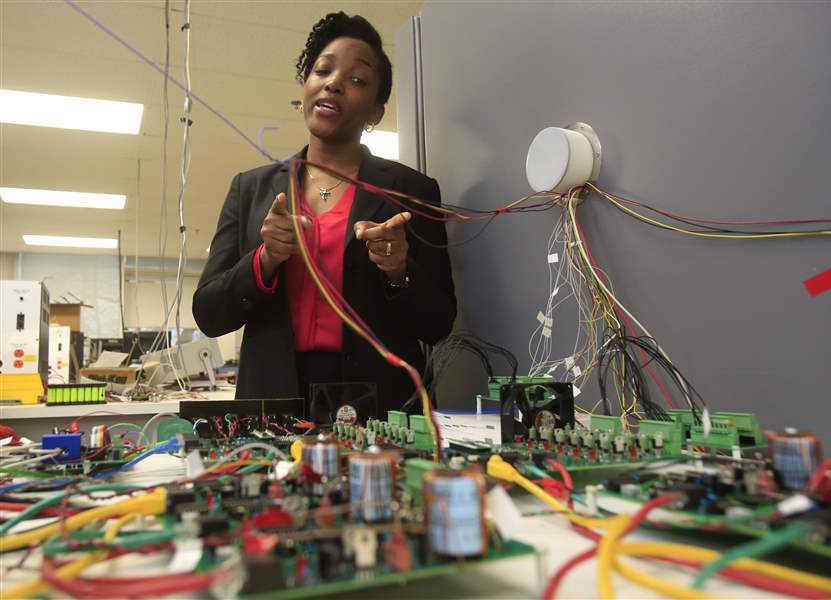
University of Toledo engineer finds power from near-death experience
3/10/2018
Ngalula "Sandrine" Mubenga nearly died as a girl in Africa because of a hospital's lack of power, and has developed a new energy storage solution to make battery packs in electric vehicles, satellites, planes and grid stations last longer and cost less.
The Blade/Kurt Steiss
Buy This Image
University of Toledo electrical engineer Ngalula "Sandrine" Mubenga says her near-death experience 20 years ago was scary but also helped spark new technology that could save lives.
Ms. Mubenga, assistant professor of electrical engineering, recently developed a bilevel equalizer to prolong battery life in electric vehicles, planes, and grid stations.
When Ms. Mubenga was 17, she was hospitalized in her hometown of Kikwit in the Democratic Republic of the Congo. She needed surgery to remove her appendix, but the hospital was without power. The city had no fuel, rendering the hospital's generator useless.
After three days of waiting, Ms. Mubenga finally had the procedure.
"That experience in the hospital is what gave me my motivation to be an electrical engineer," Ms. Mubenga said. "I was really scared for my life; I could have died at any time. So I wanted to become an engineer and learn as much as I could about renewable energy to bring electricity to places like Kikwit."
VIDEO: Ngalula "Sandrine" Mubenga
The project started in 2015 after UT engineering professor Tom Stuart gave Ms. Mubenga the idea for the bilevel equalizer. Ms. Mubenga was working on her PhD at the time, and Mr. Stuart was her adviser.
Ms. Mubenga quickly realized the task wasn't going to be easy. She demonstrated plenty of trial and error — and patience.
"It was freakin' tough," she said. "It's one thing to do it on a piece of paper, it's another to simulate it on the computer. When you get down to the prototype and actually build it and test it, this is when you really see things happen."
On several occasions, the design and computer simulations appeared fine, but then sparks flew when Ms. Mubenga flipped the power switch. The mechanism has dozens of wires and other components, and if just one malfunctions, it throws off the entire attempt.
Ms. Mubenga kept a few failed parts as reminders of how far she's come.
"Some are completely black from being burnt," Ms. Mubenga said. "And of course, there's nothing on Google about it or in your books. You have to figure it out."
The technology is the first to combine an active equalizer with a low-cost passive equalizer.
Manufacturers today balance cell voltages in a large battery pack, usually with a passive circuit which loses more energy. Active circuits are more efficient, but cost 10 times more.
Lithium ion batteries continue to drop in price, but most have a weak cell issue. One weak cell can compromise the entire battery, and the typical electric vehicle has hundreds of cells.
Ms. Mubenga's method groups the cells into sections. Each cell is balanced with a passive equalizer, and the whole section is balanced with an active equalizer. The bilevel equalizer extends battery life by about 30 percent.
"It could be huge," Mr. Stuart said. "There are several applications for this, but the obvious one is electric vehicles. One that is even much bigger is electric utilities are starting to use these batteries."
UT owns the patent on the new technology. Ms. Mubenga said the next step is to incorporate the bilevel equalizer into hybrid and electric vehicles and energy storage grids outside the lab.
She hopes to eventually sell her creation to manufacturers.
Contact Jay Skebba at jskebba@theblade.com, 419-376-9414, or on Twitter @JaySkebbaBlade.